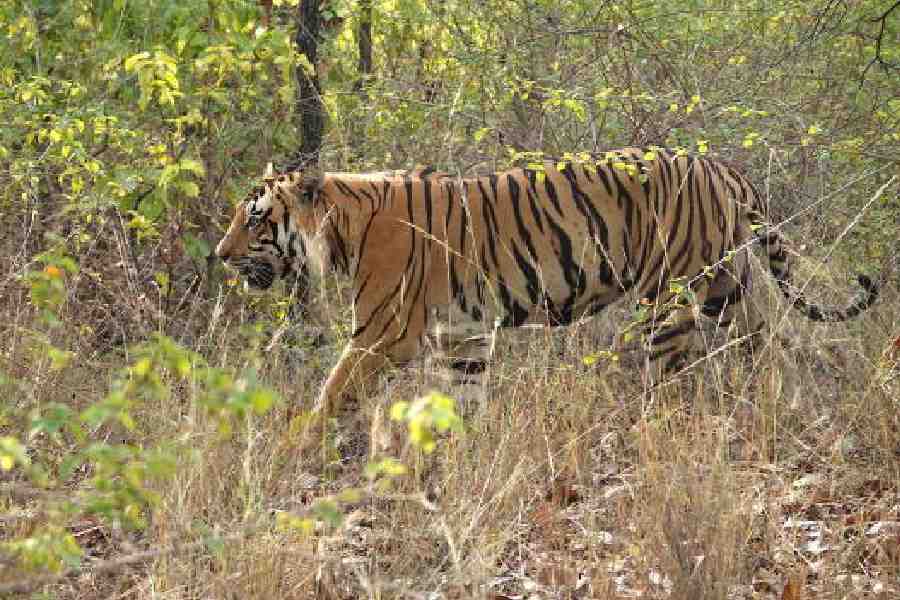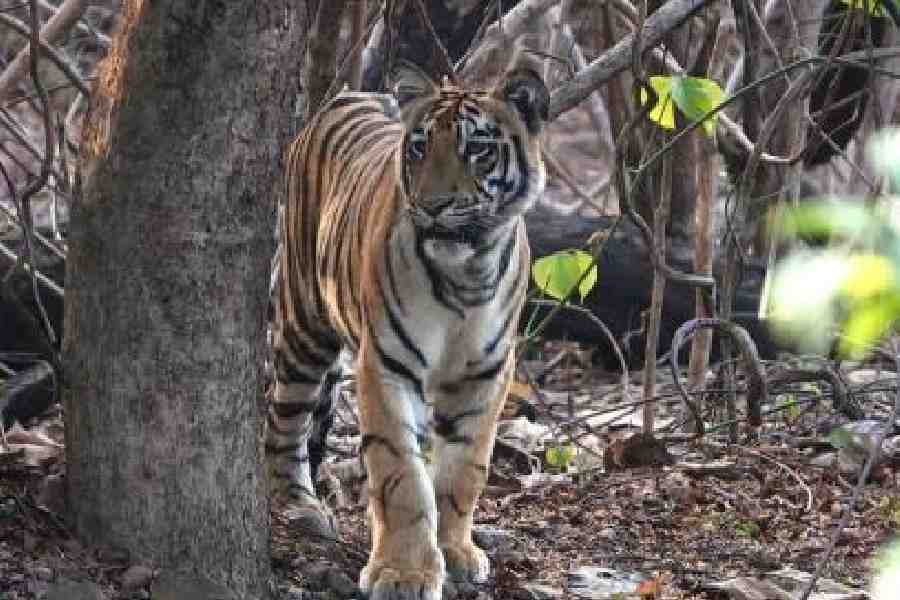The Five Find-Outers went in search of mysteries. Me, I go in search of destinations that are wild and exotic and, in the process, stumble upon some beautiful locations on the planet. Once there, I like to get “place-ready”, feeling the ground under my feet, taking in the clean air filled with known and unknown smells, marking the sights and making friends with locals. My visit to Sanjay Dubri National Park and Tiger Reserve was no different.

Mausi Maa being shy camouflaged herself
A gem in the heart of India
Located in the Sidhi district of Madhya Pradesh, Sanjay Dubri is a lesser-known national park. Upon reaching the place, I discovered the elusive peace that a city dweller is mostly on the lookout for. Look up and find birds flying in and out through majestic sal trees, putting on a rhythmic and spell-binding show. The Banas river flowing through the park adds to its charm. This was my first visit and I wondered why I had missed it so far. Inaugurated in 1975, it was initially named Sanjay Dubri Sanctuary, which was renamed Sanjay Dubri National Park in 1983 and in 2006 it was also designated as a tiger reserve so as to work towards protecting the tiger and ensure a rise their population.
Soaking up wilderness
Here is a place that is, thankfully, still not focused on touristy and often superficial issues. The villagers and local forest guards and safari drivers will candidly inform you that of the five core areas (812.5sq km) and five buffer zones (816.9sq km), only four have been developed so far for visitors. You will not be stopped from visiting the rest of the park, it falls in the ambit of the reserve but the infrastructure is poor there with no trails and bridges and the experience may leave you somewhat unhappy.
So, while on your trip it is sensible to stick to the areas developed by the Madhya Pradesh government. Other than the core and buffer areas, there is the Bagdara Sanctuary (478sq km) and Son Gariyal (209sq km) that also come under the Sanjay Dubri National Park and Tiger Reserve. I would recommend that you explore the area on a designated safari, breathe in the same air as the wild animals, listen to the birdsong, smell the rich forest vegetation, and refresh your bonds with other free forms of life. As for accommodation, do not expect luxury.

T26, one of the most sought after male tigers of the region
There is limited accommodation and the best option is to stay at the Parsili Resort by Madhya Pradesh tourism that one can book in advance. The cottages overlooking the Banas river have an excellent view and are right across the tiger corridor.
Animal trails and tales
Without a doubt, it is the tiger that draws tourists to the reserve even though it is home to more than 150 other species of birds and animals. There is the chital, nilgai, sambar, chinkara and wild dog. You will also find deer and antelope and species of hunting animals like the wolf, hyena, jackal, fox and wild cat. There is an impressive variety of birds: More than 150 species have been recorded, the most attractive among which are the oriole, blue kingfisher, grey francolin, barbet, Indian bulbul, Rufous-treepie, peacock, red-headed vulture, drongos, the lesser adjutant stork, and nightjars. You will spot members of the reptilian kingdom as well — the skink (known as saap ki mausi), chameleon, garden lizard, Bengal monitor lizard as well as snakes. Wildlife junkies rejoice, for the region abounds in some of the most venomous varieties like the krait, cobra, scaled and Russell viper and rock python.
According to the forest guards, there are at least 20 tigers currently in the park from various litter. This year (season preceding the monsoons), visitors were particularly lucky with tiger sightings, as the animals chose to move around unconcerned and unhindered in the presence of safari vehicles and we were lucky to have sighted this majestic animal in almost all the five safaris that we went on.

The Log Huts of Parsili Resort
It would be unfair to end this account without the fantastic tales of two tigresses at the park that have achieved iconic status amongst wildlife enthusiasts. The first is the story of Mausi Maa. T28 or Mausi Maa became the topic of many delightful conversations as she brought up the three orphan cubs of her sister from a different litter along with her own. As facts go, a tigress met with an unfortunate accidental death on the highway adjoining the area, leaving her four cubs defenseless. One male cub was killed by an adult male, leaving three females. After considerable discussion, the officials decided to take them to Mausi Maa as another nursing female had refused to “mother” them. To their delight and in a rare show of maternal sentiment, Mausi Maa instantly took the three motherless cubs into her care, feeding and nurturing them along with her own. The brood grew up together as siblings till they were adult tigers and claimed territories of their own.
The other tigress that occupies prime spot in mention of this reserve is Kamli. She was brought over from adjoining Bandhavgarh. Young and graceful, Kamli was the queen mother of the big cats as she was responsible for their proliferation in the reserve. Till last year, she was the partner of the dominant male of the region, T-5.
When we first sighted Mausi Maa she had smartly camouflaged herself behind a tree but we heard her roar and spotted her. Unlike at other tiger reserves, the tigers here are not exposed to huge safari vehicles and are mostly shy. It reminded me of the Tadoba National Park of 16 years ago. We were also very lucky to spot a bear cub playing with her mother.

The Banas River which flows across Sanjay Dubri National Park
Spoiler alert! It’s not a conversation starter
Sanjay Dubri National Park and Tiger Reserve doesn’t get talked about as much as Corbett National Park or Ranthambhore. It is quietly tucked away in Madhya Pradesh at 275km from Varanasi and 280km from Jabalpur, making it roughly equidistant from both. The place piqued my interest because of the interesting anecdotes I had heard about the tigers there and had resolved to visit before the monsoons came down in full force.
Whether it’s the wildlife, the simple and engaging locals, or just the stunning natural landscapes, Sanjay Dubri National Park and Tiger Reserve is a great choice for nature lovers and tiger enthusiasts alike. If you’re looking for an alternative to a buzzy, touristy, at times even hyped wildlife destination, this is the place to be in and see, not once but every season, every year.

Shiladitya Chaudhury is a communication consultant and a restaurateur who co-owns popular brands such as Oudh 1590 and Chapter 2. His passion for wildlife photography takes him to the remotest of locations. Photographs shot on Sony RX 10 Mark 4
